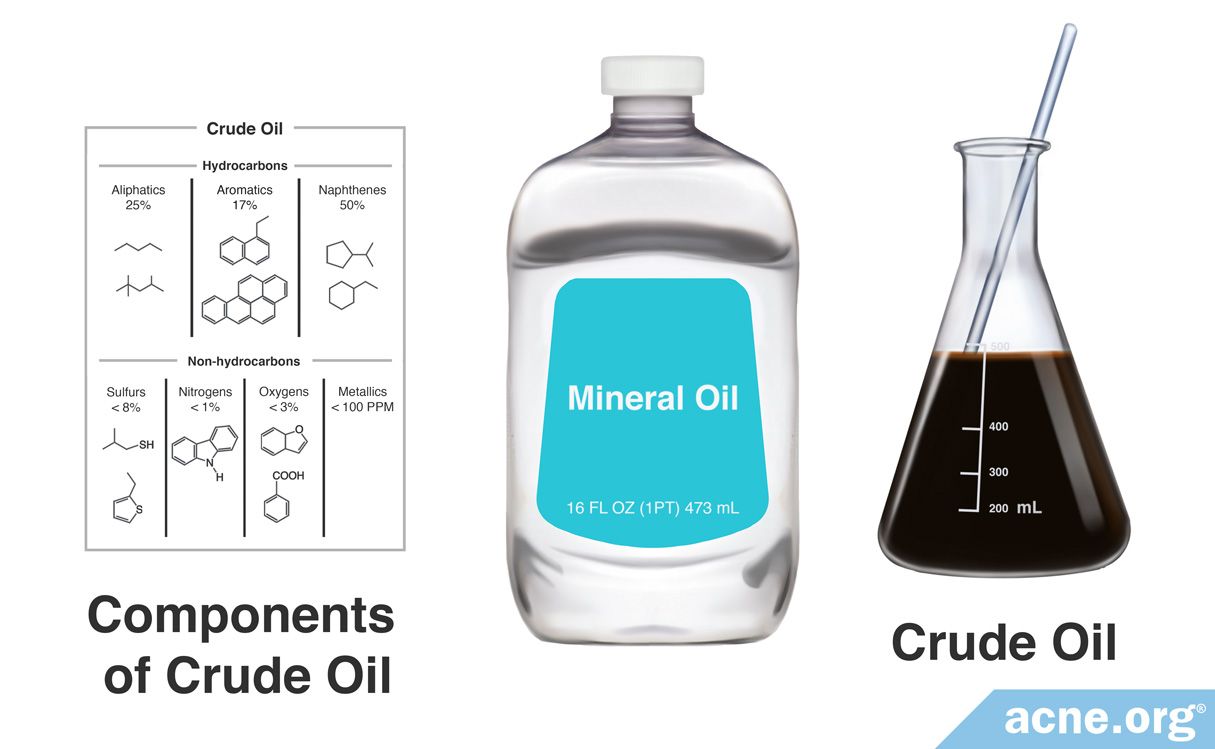Views: 0
Mineral Oil Is Safe to Use, but It Is Not Likely to Help Acne

The Essential Info
Mineral oil, also known as “baby oil” at drugstores, is a highly refined and purified oil that is created as a byproduct of refining petroleum. When applied to the skin, it creates an artificial barrier, reducing water loss from the skin.
Mineral oil is used as an ingredient in many skincare products, medications, and even some foods. It has been used in skincare products for more than 100 years, and scientists generally consider it to be safe.
Mineral oil will not clog pores and is safe to use on acne-prone skin, but there are no studies evaluating the effectiveness of it in treating acne, and based on its chemical properties, there is no reason to think it would affect acne in a positive or negative way. It is likely an inert substance when it comes to acne.
The Bottom Line: If you have acne-prone skin, you can be confident that mineral oil is a safe thing to use. It is non-toxic, unlikely to cause skin reactions, and won’t clog pores, so if you see it on an ingredient list, don’t fret. It may help soothe dry and irritated skin, but it does not offer any advantages over other non-pore-clogging oils such as jojoba oil, sunflower oil, or safflower oil, and it may not work as well to soothe your skin as these natural oils do.
My Take: When I see mineral oil listed on a product label, I still feel totally comfortable using that product, but I prefer seeing jojoba oil, sunflower oil, or safflower oil listed instead.

The Science
- Mineral Oil Safety
- How It’s Used in Cosmetics
- Mineral Oil and the Skin
- Comedogenicity (Potential to Clog Pores) of Mineral Oil
- Mineral Oil in the Treatment of Acne and Other Skin Conditions
- The Bottom Line
Mineral oil is a highly refined and purified synthetic oil that is created as a byproduct of refining petroleum. It is used in multiple products, including skin care products, medications, and even foods.1-3
Mineral Oil Safety
Scientists generally consider mineral oil to be safe for humans to use in both topical (applied to the skin) and oral forms. There is some concern about long-term use of oral mineral oil, as some studies in animals have shown signs of mineral oil toxicity after 90 days of oral use. This concern is irrelevant to most skincare and makeup products except lipstick, which may be accidentally ingested in small amounts. Fortunately, research shows that the amount of mineral oil a person might end up ingesting from wearing lipstick adds up to less than 10% of the allowable daily intake, so there is no reason to worry.4 When it comes to applying mineral oil topically, the evidence indicates that topical use of mineral oil is quite safe, and there is no evidence of any danger in exposure to topical mineral oil.5 Mineral oil does not penetrate the skin or become absorbed into the body, so there is no risk of side effects from applying mineral oil to the skin.6,7
Mineral Oil in Cosmetics
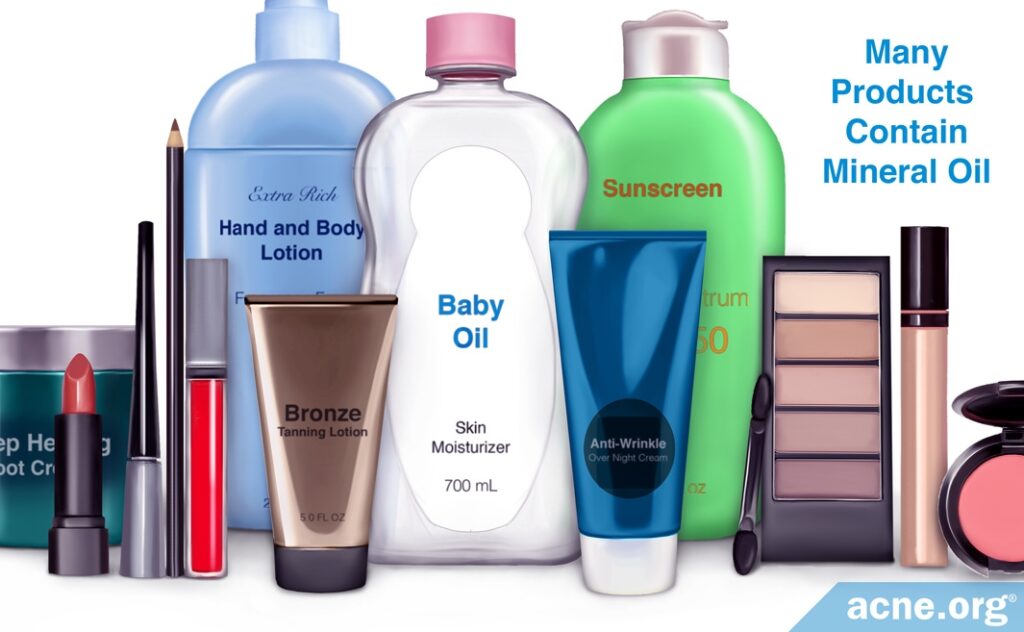
Mineral oil has been used in cosmetic products for more than 100 years. The best-known cosmetic product containing mineral oil is baby oil. Baby oil is mineral oil with fragrance added, and people use it to moisturize and soften skin, soothe skin inflammation, help treat mild eczema (an inflammatory skin disease), and clean inside the ears. For babies, mineral oil is preferable to vegetable oils because it is stable, meaning it won’t go bad in hot and humid conditions. It is also non-irritating to the skin.8
Mineral oil comes from petroleum. Because of the chemical processing involved in creating mineral oil, it does not qualify as a “natural” oil in skin care products.3
Mineral Oil and the Skin
Mineral Oil vs. Vegetable Oils
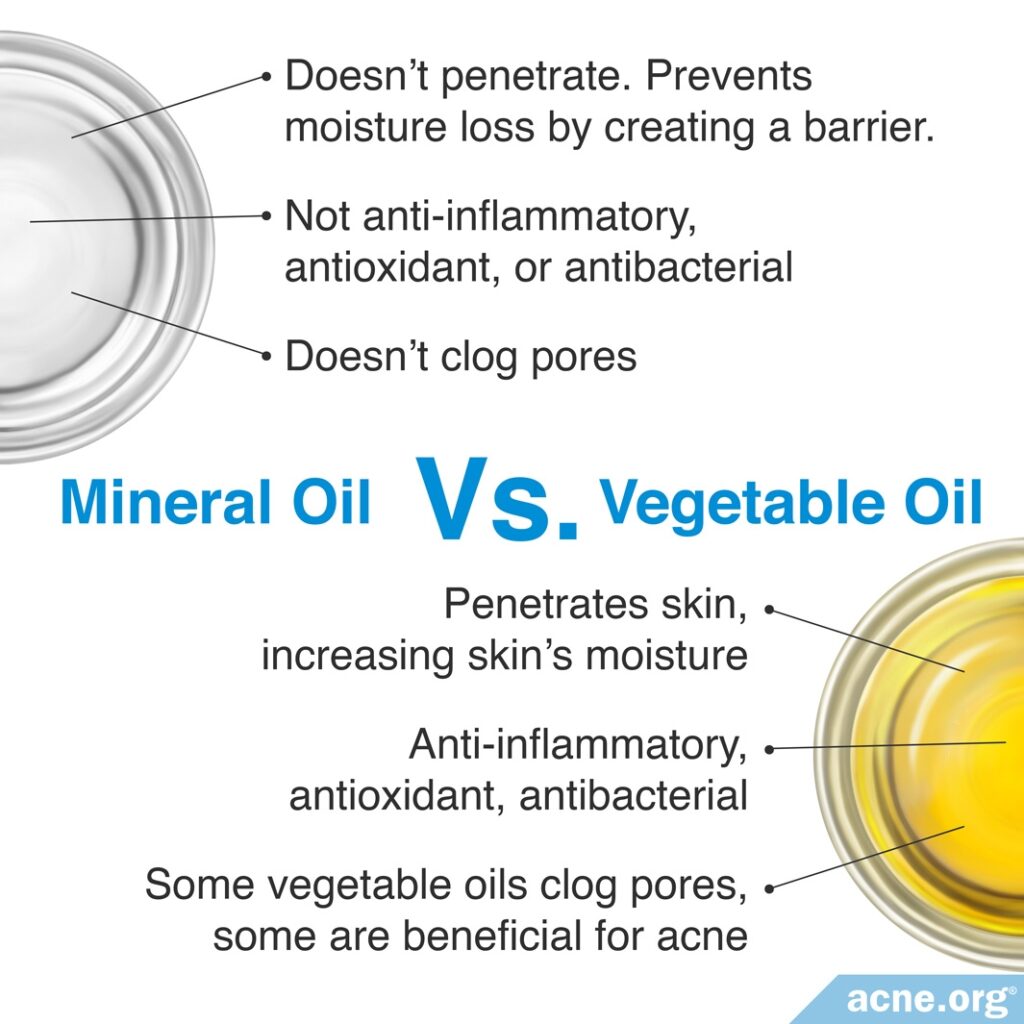
Topical skin care products, cosmetics, and medications often contain some sort of oil, either a vegetable oil (e.g. sunflower oil), or a petroleum-based product like mineral oil. All oils act as a skin moisturizer, but vegetable oils perform this function differently than mineral oil:
- Vegetable oils penetrate the deeper layers of skin and interact with molecules in the skin to increase moisture.
- Mineral oil does not penetrate beyond the outermost layer of the skin and is inert, meaning that it does not interact with skin molecules. Instead, it moisturizes by “sitting on top” of the skin and providing a barrier that keeps moisture inside the skin.3,7,9
In addition to moisturizing skin, vegetable oils provide other benefits that can help heal the skin, whereas mineral oil lacks these properties:
- Vegetable oils contain antioxidants (molecules that prevent cell damage from harmful molecules called oxidants), while mineral oil does not. Some vegetable oils also have antibacterial and anti-inflammatory properties. Lastly, because vegetable oils penetrate into the skin, they can help deliver topical medications into the skin.3,9
- Mineral oil does not contain antioxidants, does not have antibacterial or anti-inflammatory properties, and sits on top of the skin, which means it cannot help deliver topical medications.3,10,11
Reducing Side Effects of Medications
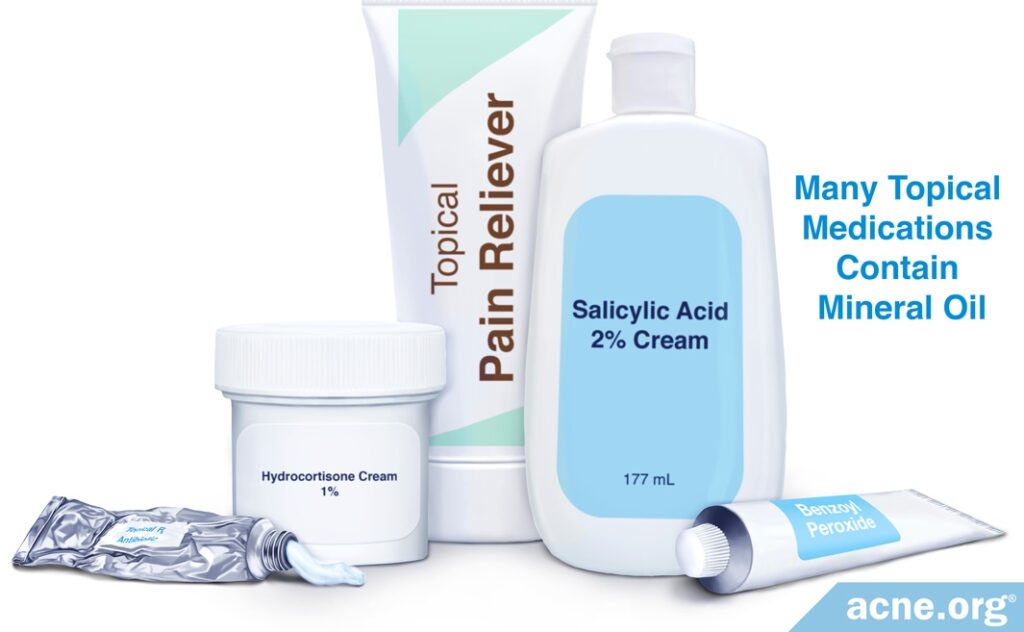
However, mineral oil may help to reduce the negative side effects of medications that cause skin irritation. For example, one study found that adding mineral oil to a topical treatment containing lactic acid reduced the stinging and burning caused by the treatment.12
Expand to read quote from study
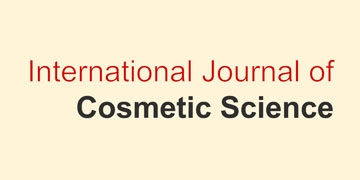
A 2007 study in the International Journal of Cosmetic Science found that adding mineral oil to a lactic acid treatment reduced the stinging and burning caused by the lactic acid. The authors concluded, “Increasing the mineral oil content…from 10% to 50% tended to decrease the stinging potential of the [lactic acid] formulation.”12
Skin Barrier Function
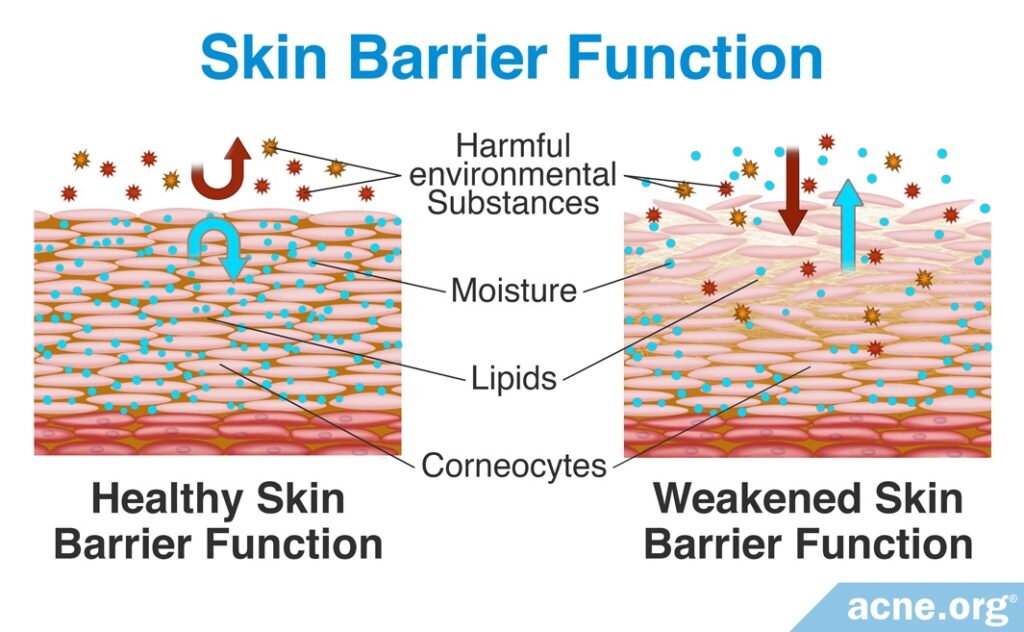
The term skin barrier function refers to the protective barrier of the outermost layer of skin. This outermost layer of skin prevents water from evaporating and drying out the skin. The skin barrier also protects skin against the environment.
When skin barrier function is impaired–as it is in acne and some other skin diseases–too much water evaporates from the skin, causing irritation. Because mineral oil sits on top of the skin, it creates an artificial barrier that traps moisture inside. This may help improve skin barrier function, at least in the short term, which could, hypothetically, be beneficial for acne.
Whether mineral oil improves skin barrier function is a matter of debate among scientists: some studies indicate that it does not improve skin barrier function, while many other studies indicate that it does.3,13
Comedogenicity (Potential to Clog Pores) of Mineral Oil
When using any oil on acne-prone skin, we need to consider whether it is comedogenic (tends to clog pores). Some oils are comedogenic, and other oils are not. Mineral oil is non-comedogenic, so it is safe to use on acne-prone skin.3
Mineral Oil in the Treatment of Acne and Other Skin Conditions
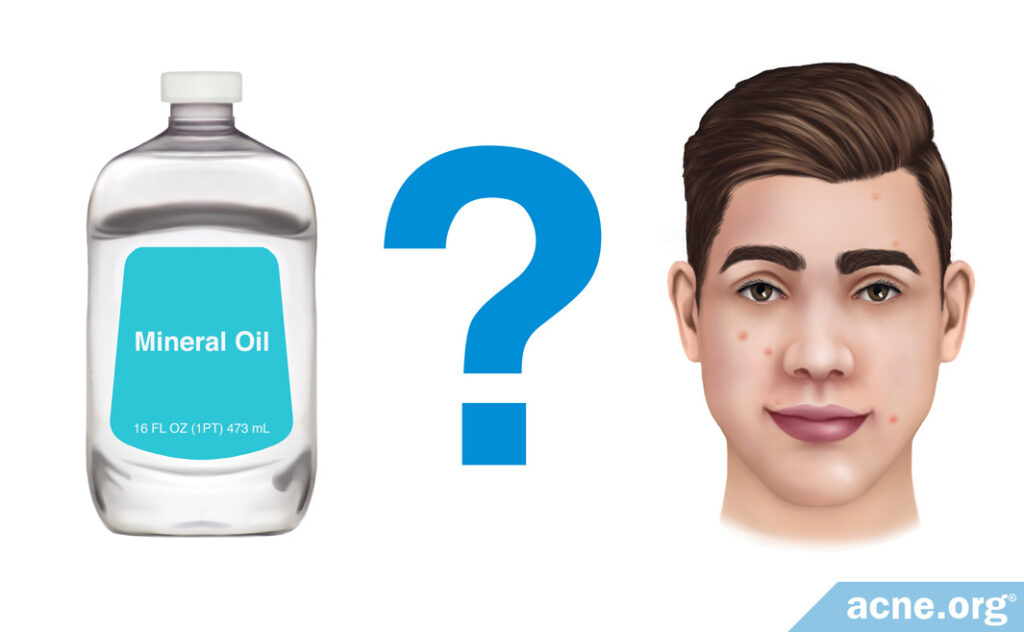
There is no research concerning the use of mineral oil in treating acne. There are a few studies that suggest that it may help in treating skin dryness and irritation in other skin conditions, though these studies also indicate that mineral oil is not as effective as other treatments for dry and irritated skin.14-16
Mineral Oil for Atopic Dermatitis
People with atopic dermatitis (eczema), which is a very common skin condition that shows itself as a red, itchy rash on the skin, have impaired skin barrier function that leads to irritation and inflammation of the skin. This is potentially interesting when it comes to acne, since people with acne also tend to have an impaired barrier function.
In one 2014 study, mineral oil reduced symptoms of atopic dermatitis, but only to a moderate degree. Would it also do the same for acne? Since atopic dermatitis and acne are different skin conditions, and mineral oil only worked to a small degree on atopic dermatitis, until we get direct research on mineral oil and acne, we should not assume mineral oil will reduce acne symptoms.
The 2014 study showed that mineral oil reduced symptoms of atopic dermatitis by 38%. Again, it is important to keep in mind that what works for atopic dermatitis may not necessarily work for acne.14
Expand to read details of study

One 2014 study in the International Journal of Dermatology compared mineral oil and virgin coconut oil in treating atopic dermatitis symptoms. This study found that mineral oil reduced symptoms by 38% and coconut oil reduced symptoms by 68%. In other words, the mineral oil helped, but it was not as effective as the coconut oil.14 However, when extending these results to potential acne treatments, it is important to know that coconut oil is highly comedogenic and may not be a good choice for acne-prone skin.
Mineral Oil for Skin Irritation
Any type of repeated physical irritation to the skin can lead to acne. The two studies we have on mineral oil and skin irritation show us that it might help reduce irritation either to a small degree or not at all.15,16
Expand to read details of studies

The first study, published in 2007 in Skin Research and Technology looked into how tissues coated in various substances might help reduce the irritation that comes from repeated use of tissues in people with allergies or the common cold. One of the lotions in the study contained mineral oil and showed that it helped, but only to a small degree. This study found that the tissues containing mineral oil did help reduce irritation, but they did not help as much as the tissues containing other ingredients.15

The second study, performed on pigs and published in 2015 in the International Journal of Cosmetic Science, looked at whether adding mineral oil or vegetable oils to cleansing products could reduce irritation in the skin of the pigs after cleansing, and showed disappointing results for mineral oil. This study found that mineral oil did not help at all, whereas sunflower seed oil did.16
The Bottom Line
While mineral oil does not appear to hold a lot of promise in treating skin conditions, including acne, it has been used for over 100 years and the evidence shows us that it appears to be a safe and inert oil that will not clog pores and should help keep the skin moisturized.
References
- Mackerer, C. R., Griffis, L. C., Grabowski Jr. J. S. & Reitman, F. A. Petroleum mineral oil refining and evaluation of cancer hazard. Appl. Occup. Environ. Hyg. 18, 890 – 901 (2003). https://www.ncbi.nlm.nih.gov/pubmed/14555442
- Kimber, I. & Carrillo, J. C. Oral exposure to mineral oils: Is there an association with immune perturbation and autoimmunity? Toxicology 344 – 346, 19 – 25 (2016). https://www.ncbi.nlm.nih.gov/pubmed/26821245
- Rawlings, A. V. & Lombard, K. J. A review on the extensive skin benefits of mineral oil. Int. J. Cosmet. Sci. 34, 511 – 518 (2012). https://www.ncbi.nlm.nih.gov/pubmed/22994201
- Chuberre, B., Araviiskaia, E., Bieber, T. & Barbaud, A. Mineral oils and waxes in cosmetics: an overview mainly based on the current European regulations and the safety profile of these compounds. J. Eur. Acad. Dermatol. Venereol. 33 Suppl 7, 5‐14 (2019). https://onlinelibrary.wiley.com/doi/full/10.1111/jdv.15946
- Nash, J. F., Gettings, S. D., Diembeck, W., Chudowski, M. & Kraus, A. L. A toxicological review of topical exposure to white mineral oils. Food Chem. Toxicol. 34, 213 – 225 (1996). https://www.ncbi.nlm.nih.gov/pubmed/8606037
- Pirow, R., Blume, A., Hellwig, N., Herzler, M., Huhse, B., Hutzler, C., Pfaff, K., Thierse, H. J., Tralau, T., Vieth, B. & Luch, A. Mineral oil in food, cosmetic products, and in products regulated by other legislations. Crit. Rev. Toxicol. 49, 742-789 (2019). https://pubmed.ncbi.nlm.nih.gov/31939687/
- Petry, T., Bury, D., Fautz, R., Hauser, M., Huber, B., Markowetz, A., Mishra, S., Rettinger, K., Schuh, W. & Teichert, T. Review of data on the dermal penetration of mineral oils and waxes used in cosmetic applications. Toxicol. Lett. 280, 70-78 (2017). https://pubmed.ncbi.nlm.nih.gov/28789996/
- Telofski, L. S., Morello, A. P. 3rd, Mack Correa, M. C. & Stamatas, G. N. The infant skin barrier: can we preserve, protect, and enhance the barrier? Dermatol. Res. Pract. 2012, 198789 (2012). https://www.ncbi.nlm.nih.gov/pmc/articles/PMC3439947/
- Verallo-Rowell, V. M., Katalbas, S. S. & Pangasinan, J. P. Natural (mineral, vegetable, coconut, essential) oils and contact dermatitis. Curr. Allergy Asthma Rep. 16, 51 – 62 (2016). https://www.ncbi.nlm.nih.gov/pubmed/27373890
- Stamatas, G. N., de Sterke, J., Hauser, M., von Stetten, O. & van der Pol, A. Lipid uptake and skin occlusion following topical application of oils on adult and infant skin. J. Dermatol. Sci. 50, 135 – 142 (2008). https://www.ncbi.nlm.nih.gov/pubmed/18164596
- Gujjar, M. & Banga, A. K. Vehicle influence on permeation through intact and compromised skin. Int. J. Pharm. 472, 362 – 368 (2014). https://www.ncbi.nlm.nih.gov/pubmed/24979534
- Sahlin, A., Edlund, F. & Lodén, M. A double-blind and controlled study on the influence of the vehicle on the skin susceptibility to stinging from lactic acid. Int. J. Cosmet. Sci. 29, 385 – 390 (2007). https://www.ncbi.nlm.nih.gov/pubmed/18489372
- Blanken, R., van Vilsteren, M. J., Turner, R. A. & Coenraads, P. J. Effect of mineral oil and linoleic-acid containing emulsions on the skin vapour loss of sodium-lauryl-sulphate-induced irritant skin reactions. Contact Dermatitis 20, 93 – 97 (1989). https://www.ncbi.nlm.nih.gov/pubmed/2706971
- Evangelista, M., Casintahan, F. & Villafuerte, L. The effect of topical virgin coconut oil on scorad, transepidermal water loss and skin capacitance in mild to moderate pediatric atopic dermatitis: A randomized, double-blind clinical trial. Int. J. Dermatol. 53, 100 – 1008 (2014). https://www.ncbi.nlm.nih.gov/pubmed/24320105
- Farage, M. A., Ebrahimpour, A., Steimle, B., Englehart, J. & Smith, D. Evaluation of lotion formulations on irritation using the modified forearm-controlled application test method. Skin Res. Technol. 13, 268 – 279 (2007). https://www.ncbi.nlm.nih.gov/pubmed/17610648
- Mukherjee, S. et al. A comparison between interactions of triglyceride oil and mineral oil with proteins and their ability to reduce cleanser surfactant-induced irritation. Int. J. Cosmet. Sci. 37, 371 – 378 (2015). https://www.ncbi.nlm.nih.gov/pubmed/25656133
The post What Is Mineral Oil, and Is It Safe to Use on Acne-prone Skin? appeared first on Acne.org.


